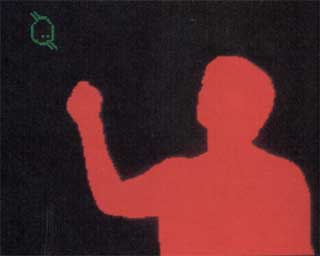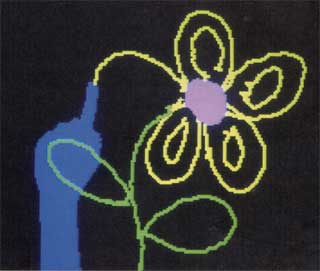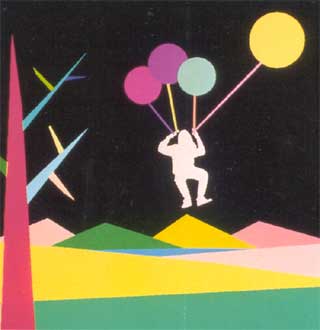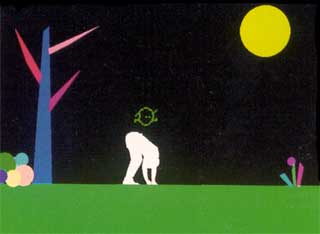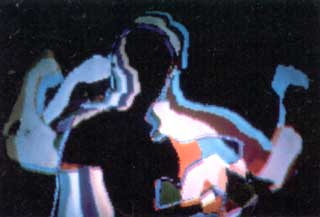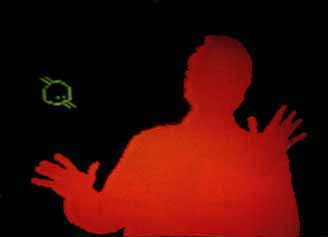
Physical environment responds to human interaction.
http://www.artmuseum.net/w2vr/timeline/Krueger.html
Myron Krueger | Responsive
Originally trained as a computer scientist, Myron Krueger, under the influence of John Cage's experiments in indeterminacy and audience participation, pioneered human-computer interaction in the context of physical environments. Beginning in 1969, he collaborated with artist and engineer colleagues to create artworks that responded to the movement and gesture of the viewer through an elaborate system of sensing floors, graphic tables, and video cameras.
At the heart of Krueger's contribution to interactive computer art was the notion of the artist as a "composer" of intelligent, real-time computer-mediated spaces, or "responsive environments," as he called them. Krueger "composed" environments, such as Videoplace from 1970, in which the computer responded to the gestures of the audience by interpreting, and even anticipating, their actions. Audience members could "touch" each other's video-generated silhouettes, as well as manipulate the odd, playful assortment of graphical objects and animated organisms that appeared on the screen, imbued with the presence of artificial life.
http://www.ccr.buffalo.edu/anstey/TEACHING/intenv_F03/krueger.html
DescriptionMyron Krueger was a physicist who believed computers had amazing potential as a tool for the creation of art works, but didn't see any artists exploiting their interactive potential. In 1969 he worked on the development of GLOW FLOW, "a computer-controlled light-sound environment that had limited provision for responding to people..." Krueger, Artificial Reality 2, Addison Wesley, 1991, p 12 Phospheresent particles were pumped trhough tubes attached to the walls of a darkened room in such a way as to distort the visitors perception of the room's shape. The glowing particles and sounds were triggered by users standing on sensors placed through the room. From 1970 he started to experiment with video tracking in search of an unemcumbered, full body interactive experience, putting together the software and hardware for what would become the Video Placesystem. On a large screen the user's silhouette and real time movements are incorporated into art works that range from a trace of the user's movements delineated in psychedelic colors to the user's interaction with "Critter" - a small creature with many autonomous behaviors who cavorts on their virtual person. Dan Sandin, who went on to became one of the inventors of the CAVE VR system, believes that computer art must incorporate either interactive or procedural elements, otherwise its just art done with computers. Kruger's work illustrates both elements - it is completed by the actions of the users; it uses algorithmic procedures to process video imagery and to create computer-controlled behavior. Other artist have continued to use video tracking in artificial arguments, although it is arguable that Video Place is still the best artwork, or series of artworks using this technology. Mine Control's Shadow Garden is a contemporary example.
http://bubblegum.parsons.edu/%7Epraveen/thesis/html/wk05_1.html
Myron Krueger
The focus of Myron Krueger in Artificial Reality II is the interaction between humans and machines, both in the immediate interface and the associated cultural relationships. He uses the concept of artificial reality as a medium of experience and as a tool to examine the relationships between people and machines. When he first coined the term in the mid-1970s, his 'goal was full-body participation in computer events that were so compelling that they would be accepted as real experience.' He wanted to create an artificial reality that would perceive human actions in a simulated world of sight, sounds, and other sensations and would make the experience of this illusion convincing. His focus was to create unencumbered, artificial realities where the humans could participate with their entire body without wearing any special instruments (be they sensors or displays) in an experience created by the computer.
The environment could be controlled by preexisting programs, or could have operators intervene and use the computer to amplify their ability to interact with people. The intention was not to reproduce conventional reality but to create synthetic realities.
Working on human-computer interaction in the University of Wisconsin in the late 1960s and early 1970s, Myron Krueger experimented and developed several computer art projects. GLOWFLOW was a computer-controlled light sound environment that responded to the people within it. In a dark empty room, four transparent tubes were attached the gallery walls. These had phosphorescent particles in water with each tube containing a different colored pigment.
The visual reference was provided by the lighted tubes that were arranged to distort the viewer's perception of the room as they caused the room to appear wider in the center than at each end. Thus, as participants walked the length of the room they felt they were going downhill with respect to their own position based on the direction of the tube!
From this initial experiment, Myron Krueger went on to develop METAPLAY which was an integration of visuals, sounds, and responsive techniques into a single framework. In this, the computer was used to create a unique real-time relationship between the participants in the gallery and the artist in another building. Live video image of the participant and a computer graphic image drawn by the artist was superimposed on the video and rear projected in th e gallery space. The viewer and the artist responded to what they saw on their respective 'screens'.
The repertoire for engagement was rich as it provided the artist a host of opportunities to draw and create varied interactions for the participants. Ex: draw on the participants image, draw a shower stall around the participant, a door that would open when the participant touched it, tic-tac-toe, etc. One game that evolved was when the artist would draw to make the participant feel that the participant was drawing. When the participant moved his hand, a line would be drawn. Thus, by moving his hand he could draw on the screen.
PSYCHIC SPACE was the next implementation where only one person interacted in the environment. The floor, walls, and ceiling were covered with black polyethylene with a rear-projected screen at one end and a phosphorescent pigment painted wall on the opposite side. The floor was divided into a sensing grid with pressure sensors which not just mapped the position of the participant but also produced sound.
MAZE, one of the interactions in this system, had a participant navigate a maze projected on the screen by moving around the room. A graphic represented the participant and responded to his movement. Participants would soon indulge in cheating to navigate the maze but such misdemeanors were built into the system and the first such transgression would lead to the elastic stretching of a line. Next the participants symbol would split into half with only one part following the movement. The other interactions were that the maze itself would shift or the maze would change, or new boundaries would appear, among others.
It was interesting to note that in all the experiments, Myron Krueger noticed that people feel a similar sense of self-consciousness with their images as they feel about their bodies. They had a proprietary feeling about their images as what happened to the image happened to them.
After several other experiments, VIDEOPLACE was created where the computer had control over the relationship between the participant's image and the objects in the graphic scene. It could coordinate the movement of a graphic object with the actions of the participant. While gravity affects the physical body, it may not control or confine the image which could float, if needed. A series of simulations could be programmed based on any action and Videoplace offered over 50 compositions and interactions (including Critter, Individual Medley, Fractal, Finger Painting, Digital Drawing, Body Surfacing, Replay, among others). To illustrate, when the participant's silhouette pushed a graphic object-the computer could choose to move the object or the silhouette. Or, as in Finger Painting where each finger created flowing paint without the distraction of the silhouette.
In the installation, the participant faced a video-projection screen while the screen behind him was backlit to produce high contrast images for the camera (in front of the projection screen) and allow the computer to distinguish the participant from the background.
The participant's image would be digitized to create silhouettes which could be analyzed by specialized processors. The processors could analyze the image's posture, rate of movement, and its relationship to other graphic objects in the system. They could then react to the movement of the participant and create a series of responses-be they visual or auditory reactions. Two or more environments could also be linked.

